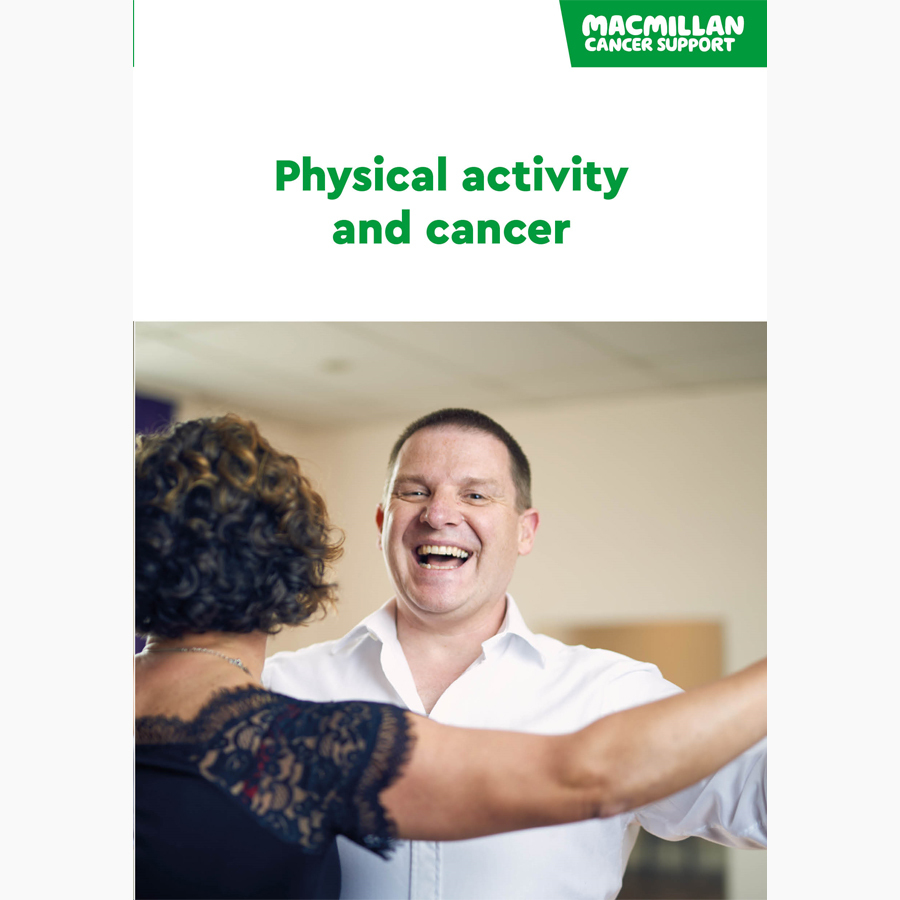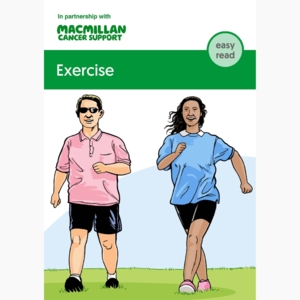Physical activity and cancer
What is physical activity?
Physical activity is any type of exercise or movement that uses your muscles. This includes everyday activities such as walking, housework and gardening. Any activity will help maintain or improve your fitness, health and well-being.
Being active before, during and after cancer treatment is safe. But before starting any physical activity plan, it is important to talk to a healthcare professional first.
Once you have started, you will probably find that being active becomes an enjoyable part of your life. You may notice the benefits quite quickly, such as feeling less tired and stressed, and having more confidence. Noticing these changes and knowing the benefits to your health can keep you motivated, even on difficult days.
Booklets and resources
What are the benefits of physical activity for cancer?
Before, during and after cancer treatment, being active can:
- reduce tiredness
- be good for your heart
- improve your mood and emotional well-being
- reduce anxiety and depression
- help you keep to a healthy weight
- strengthen your muscles
- improve bone health
- improve your flexibility and help with stiffness
- improve balance
- increase your confidence.
There can be extra or specific benefits, depending on which stage of treatment you are at.
How does physical activity affect cancer?
Regular physical activity can help reduce the risk of some cancers. It can also help reduce the risk of developing other health problems, such as heart disease, stroke and diabetes.
Research also suggests that along with having a healthy diet, being physically active can help reduce the risk of some cancer types coming back.
Related pages
Being active before treatment
Being active before you start cancer treatment may:
- improve your general fitness
- help you recover more quickly
- mean you have fewer side effects, or that they are less severe
- help you feel more in control and mentally prepared for treatment.
You may not have much time before starting treatment, but even making small changes to your physical activity, diet and lifestyle can help.
What is prehabilitation?
If you know you are going to have treatment, your doctor might encourage you to start some physical activity beforehand. You may hear them using the term prehabilitation, or prehab for short. Prehab means getting you as ready for treatment as you can be. To help you prepare, your team may give you advice and support about:
- physical activity or exercise
- healthy diet and weight
- stopping smoking
- reducing alcohol intake
- mental health and well-being.
We have some prehabilitation videos for people living with cancer.
Being active during and after treatment
Some people have to start treatment straight away, so there is no time to become more active before treatment. If this happens, you can talk to your cancer doctor or specialist nurse about plans to get active during or after treatment.
Being active is generally safe whatever stage of treatment. But there may be some things you need to be aware of or avoid doing.
Related pages
How much activity should you do?
There are international guidelines for physical activity and cancer. They were developed by the American College of Sports Medicine. The guidelines state:
- physical activity is safe during and after cancer treatment
- you should try to avoid being inactive
- you should try to get back to your normal activities as soon as possible after treatment.
For some people, this can feel overwhelming. You can start slow and try to build up to the recommended physical activity levels. Doing something is better than doing nothing. It is important to listen to your body and do what you feel able to do.
Aerobic activity
Aerobic activity is physical activity that increases your breathing. It can make you sweat and your heartbeat faster. Examples of aerobic activity include brisk walking, running or cycling. UK guidelines recommend that all adults do 1 of the following every week:
- At least 2½ hours (150 minutes) of moderate intensity activity. This means activity that causes you to breathe faster, but you can still talk.
- At least 1¼ hours (75 minutes) of vigorous intensity aerobic activity. This means activity that causes you to breathe very hard, so that you cannot have a conversation.
- A combination of both moderate and vigorous aerobic activity.
To do 150 minutes of moderate activity in a week, you could do 30 minutes of activity on 5 days of the week. On the 5 days of physical activity, you could do three 10-minute sessions during the day.
Strength, balance and stretching
As well as doing a certain amount of aerobic activity, the guidelines also recommend that you try to do the following:
- Activities that improve muscle strength on at least 2 days of the week.
- If you are at risk of falling, try to do activities that improve co-ordination and balance on at least 2 days of the week. This could be a strength and balance class, tai chi or yoga
- Do stretching exercises before and after each session.
For some people, activities that improve muscle strength and balance may be more helpful than aerobic activity. It depends on the stage of cancer or treatment. A physiotherapist, clinical exercise physiologist or cancer exercise specialist may be able to give you some advice about which activities are most suitable for you.
Being active every day
If you are doing exercise sessions run by a professional, it is still important to make physical activity part of your daily routine. You could:
- reduce the amount of time you spend sitting or lying down
- choose the stairs rather than the lift when possible, even if it is only part of the way up
- stand up and stretch your legs every 30 minutes if you work sitting down – setting reminders on your watch or phone can help with this
- walk or cycle shorter distances rather than use the car
- get off the bus a stop earlier or later and walk the extra distance.
The infographic below shows the amount of physical activity recommended for adults. It also suggests ways of doing it.
Physical activity guide
Who can help you get started?
If you need ideas to help you get started or advice about finding activities near you, our information about types of physical activity may help. We also have information about exercising safely when you have cancer.
You can hear from people living with cancer about how keeping physically active has helped them in our common questions about physical activity and cancer.
You can also visit our Online Community to:
- talk with people who have been affected by cancer
- ask an expert your questions about getting active before, during or after your cancer treatment.
If you feel worried about starting physical activity, it can help to get advice. Who you talk to will depend on who is involved in your care. There are lots of different services that may be able to help answer your questions or refer you to the right people to help.
The following professionals can help you.
-
Your doctor or nurse
It is best to talk to your cancer doctor, specialist nurse or GP if you are new to exercising or if you have any concerns before you start exercising. They can give you advice on whether it is safe for you to exercise. They can also give you information about any precautions you need to take.
Some GPs, cancer treatment centres and support groups have exercise referral schemes. These can refer you to a cancer exercise specialist or a clinical exercise physiologist. This will depend on where you live in the UK. There may also be an exercise programme that is part of some research at your cancer treatment centre. Ask your cancer doctor or specialist nurse for more information.
Your GP, cancer doctor or specialist nurse can refer you to a physiotherapist. Some areas may have qualified cancer exercise specialists or clinical exercise physiologists who you can be referred to. You may also be able to refer yourself to a physiotherapist.
-
A physiotherapist, cancer exercise specialist or clinical exercise physiologist
A physiotherapist is someone who gives advice about exercise and mobility. They can give you exercises to try at home and may be able to give you information about classes in your area.
A cancer exercise specialist is a fitness instructor who is qualified to help people with cancer to exercise safely. They might work in a gym or local leisure centre. They might offer personal training. This can help you come up with a program of exercise to suit your basic needs and likes. Some cancer exercise specialists may offer classes in cancer information centres.
A clinical exercise physiologist is a healthcare professional who is an expert in screening, assessing and advising what physical activity is best for you and your situation.
A cancer exercise specialist, physiotherapist or clinical exercise physiologist can help you:
- decide on an exercise programme that is safe and effective for you
- assess and treat any specific issues you have – for example limited movement due to surgery
- be able to exercise on your own
- increase your aerobic fitness level
- improve your energy, strength, flexibility, co-ordination and balance
- manage the side effects or late effects of treatment
- enjoy and increase your physical activity
- avoid injuries
- improve your confidence and make you feel more in control.
-
An occupational therapist
Your GP or cancer doctor may refer you to an occupational therapist. They can advise you on how to pace yourself and manage tiredness. They may be able to teach you strategies to help you conserve your energy and manage symptoms such as breathlessness.
They can also suggest changes to your home or how you complete daily tasks. These can make tasks safer for you, and help you be more independent. Doing simple things for yourself in the home is a way of increasing your physical activity. If things are easier at home, you will also have more time and energy to do activities you like, such as walking or gardening.
About our information
This information has been written, revised and edited by Macmillan Cancer Support’s Cancer Information Development team. It has been reviewed by expert medical and health professionals and people living with cancer.
-
References
Below is a sample of the sources used in our physical activity information. If you would like more information about the sources we use, please contact us at cancerinformationteam@macmillan.org.uk
Campbell K, Winters-Stone K, Wiskemann J, et al. Exercise guidelines for cancer survivors: consensus statement from international multidisciplinary roundtable. Med Sci Sports Exerc. 2019 November; 51911): 2375-2390 [accessed February 2023].
www.gov.uk Physical activity for adults and older adults: 19 and over [accessed February 2023].
Date reviewed

Our cancer information meets the PIF TICK quality mark.
This means it is easy to use, up-to-date and based on the latest evidence. Learn more about how we produce our information.
The language we use
We want everyone affected by cancer to feel our information is written for them.
We want our information to be as clear as possible. To do this, we try to:
- use plain English
- explain medical words
- use short sentences
- use illustrations to explain text
- structure the information clearly
- make sure important points are clear.
We use gender-inclusive language and talk to our readers as ‘you’ so that everyone feels included. Where clinically necessary we use the terms ‘men’ and ‘women’ or ‘male’ and ‘female’. For example, we do so when talking about parts of the body or mentioning statistics or research about who is affected.
You can read more about how we produce our information here.






